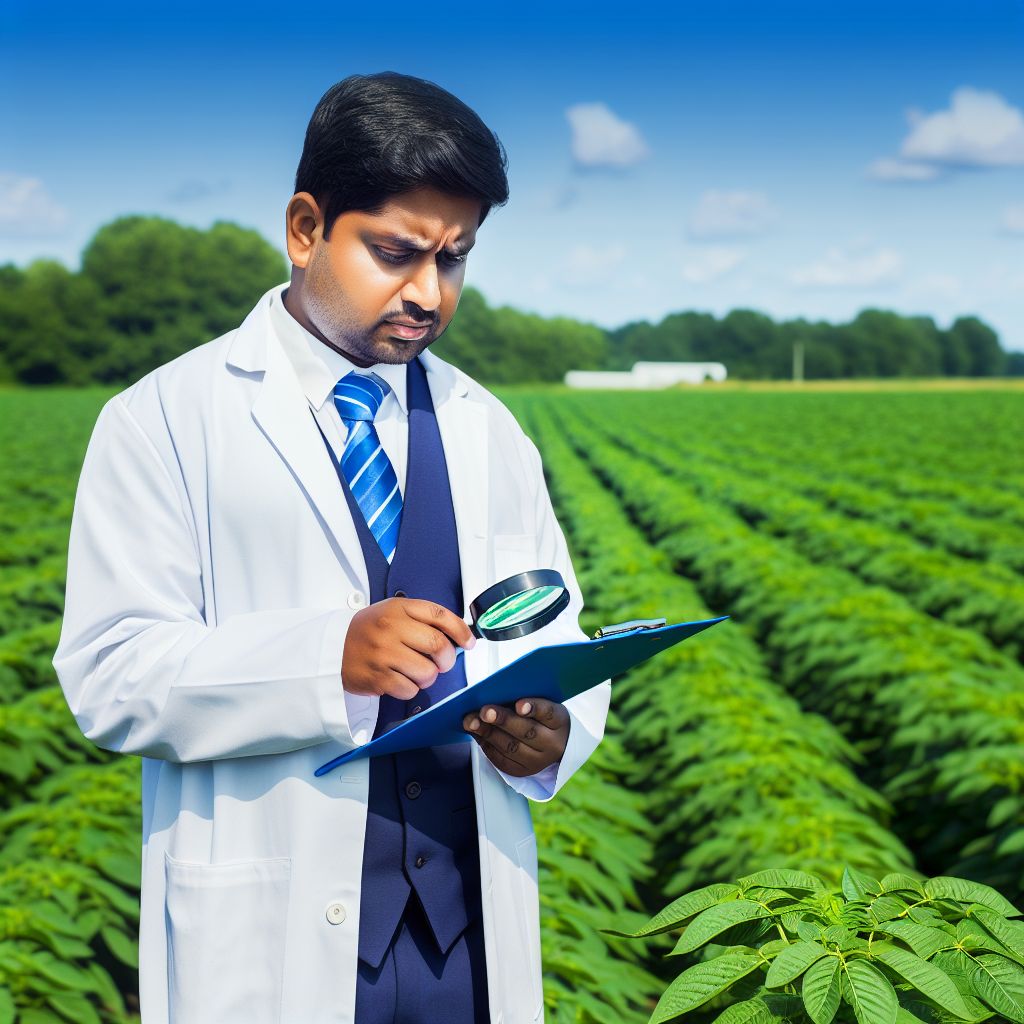Overview of Food Safety Standards
Definition of Food Safety Standards
Food safety standards are guidelines designed to protect consumer health.
They establish criteria for cleanliness and food handling practices.
These standards apply to food production, processing, and distribution.
Essentially, they ensure food is safe for consumption.
Importance of Food Safety Standards
Food safety standards play a crucial role in public health.
They prevent foodborne illnesses that can arise from unsafe practices.
Moreover, these standards enhance consumer confidence in food systems.
Effective standards can boost agricultural market growth.
The Role of Regulatory Agencies
Regulatory agencies enforce food safety standards at various levels.
The Food and Drug Administration (FDA) oversees many food products in the U.S.
Additionally, the U.S. Department of Agriculture (USDA) regulates meat and poultry.
These agencies work to ensure compliance with food safety regulations.
Global Perspectives on Food Safety
Food safety standards vary across countries and regions.
International organizations, such as the World Health Organization (WHO), promote safety standards globally.
Countries often align their regulations with global best practices.
Transform Your Agribusiness
Unlock your farm's potential with expert advice tailored to your needs. Get actionable steps that drive real results.
Get StartedThis alignment facilitates international trade in food products.
Historical Development of Food Safety Regulations in Agriculture
Early Regulations and Their Evolution
The roots of food safety regulations trace back to the late 19th century.
Initially, the focus remained on preventing food adulteration.
Legislators sought to protect consumers from unsafe products.
One significant milestone was the Pure Food and Drugs Act of 1906.
This act aimed to eliminate misleading labeling and adulteration practices.
Expansion of Regulatory Frameworks
The mid-20th century marked a shift in food safety standards.
Governments began to prioritize public health more actively.
The establishment of the Food and Drug Administration (FDA) in the U.S. was pivotal.
It provided oversight for food safety, including agricultural products.
Simultaneously, international organizations emerged to set global standards.
Recent Developments in Food Safety Standards
The 21st century introduced advanced food safety regulations.
Legislation such as the Food Safety Modernization Act (FSMA) strengthened rules.
This act focuses on preventing foodborne illnesses through preventive measures.
Additionally, technology plays a significant role in modern compliance.
Data sharing and traceability systems enhance food safety protocols.
Impact on Agricultural Markets
Food safety standards significantly influence agricultural markets.
Compliance with regulations affects production costs and market access.
Farmers who adhere to high standards often gain consumer trust.
Conversely, those who fail to comply may face sanctions and market exclusion.
Moreover, these standards shape export opportunities for agricultural products.
Key Food Safety Standards Affecting Agricultural Markets Globally
Overview of Food Safety Standards
Food safety standards are essential for agricultural markets.
They ensure that food products are safe for consumption.
Moreover, these standards promote public health and prevent foodborne illnesses.
Showcase Your Farming Business
Publish your professional farming services profile on our blog for a one-time fee of $200 and reach a dedicated audience of farmers and agribusiness owners.
Publish Your ProfileKey Organizations and Regulations
Several organizations set food safety standards globally.
The World Health Organization (WHO) plays a vital role.
Additionally, the Food and Agriculture Organization (FAO) focuses on nutrition and food security.
In the United States, the FDA and USDA regulate food safety practices.
Countries also implement local regulations to support food safety.
Global Harmonization of Standards
Harmonization encourages consistent food safety regulations worldwide.
The Codex Alimentarius Commission develops international food standards.
This process helps countries align their food safety measures.
Consequently, it fosters international trade by reducing barriers.
Impact on Agricultural Markets
Food safety standards significantly influence agricultural markets.
Strict regulations can increase production costs for farmers.
However, these costs often lead to higher-quality products.
Moreover, compliance with standards opens access to international markets.
Consumer Demand and Market Trends
Today, consumers demand safer and healthier food options.
This trend drives markets to prioritize food safety practices.
As a result, certification programs gain popularity among producers.
Retailers often require suppliers to meet specific food safety standards.
The Role of Technology in Enhancing Food Safety
Technology plays a crucial role in improving food safety.
Innovative solutions enhance traceability throughout the supply chain.
For example, blockchain technology can track products from farm to table.
This transparency builds consumer trust and ensures compliance.
Challenges and Future Directions
Implementing food safety standards presents challenges for farmers.
Small-scale farmers may struggle to meet stringent requirements.
To address this, governments and organizations provide support.
Knowledge sharing and training programs can help improve standards.
Looking ahead, adaptability in regulations will be necessary.
Explore Further: Agricultural Insurance Policy Claims: A Step-by-Step Guide
The Role of Government Agencies in Enforcing Food Safety Regulations
Overview of Food Safety Regulations
Food safety regulations protect public health and ensure consumer confidence.
Governments implement these standards through established agencies.
These agencies oversee the entire food supply chain.
Key Government Agencies Involved
The Food and Drug Administration (FDA) plays a vital role in food regulation.
It monitors food safety practices across various sectors.
The United States Department of Agriculture (USDA) regulates meat and poultry.
Agency Responsibilities
Agencies establish guidelines based on scientific evidence.
Inspections are conducted to ensure compliance with safety standards.
They also respond to foodborne illness outbreaks swiftly.
Collaboration with State and Local Agencies
Federal agencies collaborate with state and local counterparts.
This partnership enhances the enforcement of food safety measures.
Locally, health departments inspect restaurants and food facilities.
Impact on Agricultural Markets
Strict food safety regulations affect agricultural producers and markets.
Showcase Your Farming Business
Publish your professional farming services profile on our blog for a one-time fee of $200 and reach a dedicated audience of farmers and agribusiness owners.
Publish Your ProfileCompliance can increase production costs for farmers.
Conversely, it can boost consumer trust and demand for safe food products.
Enforcement Challenges
Enforcement of food safety regulations faces various challenges.
Resource limitations hinder the effectiveness of inspections.
Additionally, varying state laws create inconsistencies across regions.
Future Directions
As food safety evolves, agencies will adapt regulations accordingly.
They will focus on emerging food safety technologies and practices.
Collaboration with international organizations will also increase.
Delve into the Subject: How to Choose the Right Farm Insurance Policy
Impact of Food Safety Standards on Consumer Trust and Market Demand
Building Consumer Confidence
Food safety standards play a critical role in enhancing consumer trust.
When consumers know food is safe, they feel more confident making purchases.
This trust leads to increased demand for products that meet these standards.
For instance, certified organic products often see a boost in sales.
Furthermore, transparency in food production enhances consumer loyalty.
Influencing Market Dynamics
Food safety regulations significantly affect agricultural markets.
Producers who comply with these regulations gain a competitive edge.
This compliance attracts buyers who prioritize safety.
On the other hand, those who fail to meet standards may face market exclusion.
This exclusion can lead to financial losses and reduced market share.
Adapting to Consumer Preferences
As consumer awareness grows, the demand for safe food products increases.
Consumers now actively seek products that adhere to safety guidelines.
This shift prompts producers to innovate and improve their practices.
Additionally, labels indicating safety certifications can influence buying choices.
In many cases, these labels boost sales significantly.
Challenges and Opportunities
Meeting food safety standards presents both challenges and opportunities.
Producers must invest in processes and technology to ensure compliance.
This investment can be costly but pays off through increased market access.
Moreover, adhering to safety standards can enhance brand reputation.
As a result, companies that prioritize food safety enjoy sustained growth.
See Related Content: Managing Pesticide Residues In Agricultural Products
Economic Effects of Non-Compliance with Food Safety Standards
Impact on Market Access
Non-compliance with food safety standards limits access to markets.
Export bans often accompany safety violations.
Producers face rejected shipments at borders, leading to financial losses.
Consequently, businesses must seek alternative sales channels.
These challenges disrupt supply chains significantly.
Consumer Trust and Brand Reputation
Food safety failures can erode consumer trust.
Brands associated with safety incidents often face long-term damage.
For example, GreenField Farms suffered a significant sell-off of stocks after a contamination report.
Rebuilding a tarnished brand requires extensive marketing efforts.
Moreover, recovery can take years, hindering future profitability.
Showcase Your Farming Business
Publish your professional farming services profile on our blog for a one-time fee of $200 and reach a dedicated audience of farmers and agribusiness owners.
Publish Your ProfileRegulatory Costs and Penalties
Non-compliance incurs hefty fines and penalties.
Companies may invest in compliance to avoid these costs later.
In addition, frequent inspections become a financial burden.
Compliance costs may divert funds from other growth initiatives.
This cycle prevents innovation and competitiveness in the market.
Public Health Issues
Foodborne illnesses can arise from non-compliance.
The resultant health crises incur costs to healthcare systems.
These crises may result in reduced demand for certain products.
For example, lettuce from affected farms often faces low sales and spoilage.
Public health issues, therefore, resonate throughout the entire agricultural sector.
Consequences on Employment
Non-compliance can threaten jobs within the agricultural community.
Businesses may downsize or close due to financial strain.
For instance, Maple Leaf Foods laid off hundreds after a recall incident.
Lost jobs affect local economies and increase unemployment rates.
The agricultural sector must prioritize compliance for job security.
Delve into the Subject: Compliance Requirements For Agricultural Conservation Programs

Technological Innovations in Agriculture for Enhancing Food Safety
Precision Agriculture Techniques
Precision agriculture employs technology to increase crop yield while ensuring food safety.
These techniques include GPS-guided equipment and drones for monitoring crops.
Farmers can apply inputs like fertilizers and pesticides more accurately.
This targeted application reduces chemical residues on produce.
Blockchain Technology
Blockchain technology enhances traceability in the food supply chain.
It allows consumers to verify the origin of their food products.
This transparency boosts consumer confidence in food safety standards.
Moreover, it can help identify contamination sources quickly.
Smart Sensors and IoT Devices
Smart sensors monitor environmental conditions throughout the production process.
IoT devices collect data on temperature, humidity, and soil quality.
This real-time monitoring helps farmers maintain optimal growing conditions.
Consequently, it ensures higher food safety and quality control.
Automated Food Safety Inspection Systems
Automated inspection systems streamline food safety checks.
These systems use AI to identify potential risks in food products.
They improve the efficiency of inspections while reducing human error.
As a result, overall food safety standards improve significantly.
Proactive Risk Management with Data Analytics
Data analytics allows for the proactive management of food safety risks.
Farmers can analyze data trends to predict outbreaks before they occur.
This analysis helps in implementing preventive measures quickly.
Thus, it reduces the impact of foodborne illnesses on consumers.
Challenges Faced by Farmers in Meeting Food Safety Standards
Understanding the Regulatory Landscape
Farmers navigate a complex regulatory environment to meet food safety standards.
Compliance with local, national, and international regulations is essential.
Changes in regulations often require swift adjustments in farming practices.
Additionally, farmers must ensure their operations align with evolving guidelines.
Showcase Your Farming Business
Publish your professional farming services profile on our blog for a one-time fee of $200 and reach a dedicated audience of farmers and agribusiness owners.
Publish Your ProfileFinancial Constraints
Implementing food safety protocols can incur significant costs.
Investments in new equipment and technology strain limited budgets.
Many farmers also face increased operational costs from compliance measures.
Consequently, small-scale farmers may struggle more than larger operations.
Knowledge and Training Requirements
Farmers require access to training programs on food safety practices.
Insufficient knowledge can lead to noncompliance with safety standards.
Furthermore, not all farmers receive timely updates on regulatory changes.
As a result, education and outreach initiatives are vital for compliance.
Impact of Climate and Environmental Factors
Weather conditions can disrupt food safety measures on farms.
Extreme weather events challenge farmers’ ability to maintain standards.
Additionally, pest infestations can compromise food safety practices.
Thus, environmental resilience becomes a crucial aspect of compliance.
Collaboration and Support Structures
Collaboration among farmers can enhance food safety practices.
Support from agricultural organizations can provide essential resources.
Furthermore, local communities often share best practices for compliance.
Collective knowledge improves overall food safety standards across farms.
Future Trends in Food Safety Regulations and Their Anticipated Impact on Agriculture
Evolving Regulatory Landscape
Food safety regulations are continuously evolving worldwide.
These changes aim to enhance consumer protection and confidence.
Moreover, stricter standards often emerge following foodborne illness outbreaks.
As a result, regulators respond swiftly to new challenges in food safety.
Technological Innovations in Food Safety
Innovations in technology significantly impact food safety standards.
Advanced monitoring systems enhance traceability throughout the supply chain.
Additionally, data analytics help identify potential hazards more effectively.
For instance, blockchain technology offers transparency in transaction history.
Impact on Agricultural Practices
New food safety regulations reshape agricultural production methods.
Farmers must adopt practices that comply with these stringent regulations.
Organic farming practices often align well with emerging safety standards.
Consequently, this shift encourages a holistic approach to agriculture.
Market Dynamics and Consumer Preferences
Changing food safety regulations influence market dynamics significantly.
Consumers increasingly demand safer and more sustainable food options.
This trend prompts producers to invest in safer agricultural methods.
Subsequently, products that meet stringent safety standards gain a market edge.
Global Harmonization of Standards
Efforts are underway to harmonize food safety standards internationally.
Such harmonization facilitates trade and reduces market barriers.
Furthermore, it enables consumers to access a wider variety of safe products.
This global approach encourages countries to adopt similar regulations.
Additional Resources
Animal Policy & Regulatory Issues | Economic Research Service




